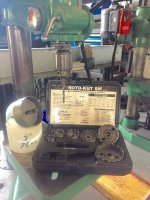I often see instructions for large holes that say to gradually increase drill bit sizes to reach your target size. For example, "For a 5/8 hole, drill 1/4, 3/8, 1/2, then 5/8." I used to do this but often ended up with chipped corners on large bits.
Then I tried the less often recommended method of drilling about a 1/8 pilot hole before using the final size bit. The small pilot hole lets the large bit cut without having to force the non-cutting center portion through the steel, and the full width of the cutting edge is used instead of just the corners. This works better for me.
How do you do it?
Bruce
Then I tried the less often recommended method of drilling about a 1/8 pilot hole before using the final size bit. The small pilot hole lets the large bit cut without having to force the non-cutting center portion through the steel, and the full width of the cutting edge is used instead of just the corners. This works better for me.
How do you do it?
Bruce


